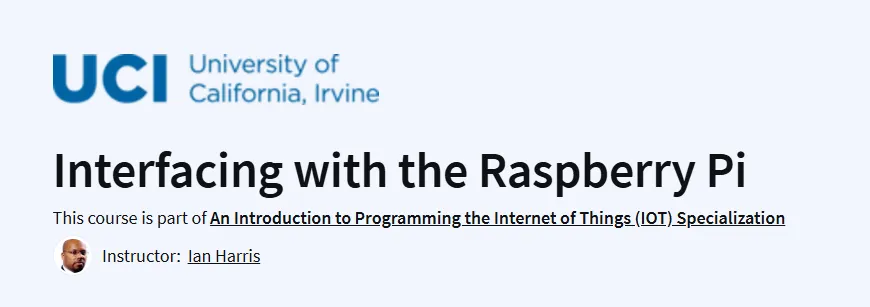What you will learn in Interfacing with the Raspberry Pi Course
- Raspberry Pi GPIO programming
- Sensor interfacing (temperature, motion, light)
- Peripheral communication protocols (I2C, SPI, UART)
- Python libraries for hardware control
- Basic circuit design for Pi projects
- IoT application development
- Troubleshooting common interface issues
Program Overview
Raspberry Pi Setup
⏱️ 2 weeks
- Covers OS installation, remote access, and GPIO pin configuration.
- Includes breadboard prototyping basics.
Digital I/O Programming
⏱️ 2 weeks
- Focuses on button inputs, LED control, and relay interfacing.
- Features interrupt-driven programming.
Sensor Integration
⏱️ 2 weeks
- Teaches analog sensor reading (via ADC), environmental sensors, and serial communication.
- Includes data logging projects.
Advanced Interfaces
⏱️ 2 weeks
- Examines motor control, display modules, and wireless communication.
- Features complete IoT system integration.
Get certificate
Job Outlook
- Professional value: Essential for embedded systems
- Salary potential: 75K130K for IoT developers
- Industry demand: 25% growth in prototyping roles
- Certification benefit: Recognized by maker communities
Specification: Interfacing with the Raspberry Pi
|
FAQs
- A Raspberry Pi with GPIO support (any modern Pi model works well).
- LEDs, resistors, prototype breadboard, and jumper wires for simple circuit projects like blinking lights or servo control.
- A Raspberry Pi camera module and servos, as labs involve using the picamera library and generating PWM signals.
- Prepared to interface with sensors, motors, GPS modules, and LCDs, often via HDMI, USB, and Ethernet ports.
- No specialized expansion boards are mandatory—but familiarity with digital and analog signals is important for successful hardware interfacing.
- Teaches how to operate the Pi as a networked Linux device, not just as a standalone mini-computer—vital for IoT work.
- Covers Python socket programming, enabling your Pi to act as a client or server—foundational for IoT communication.
- Shows how to work with public APIs via Twython, helping you integrate cloud services for notifications or data exchange.
- Demonstrates how to interface with actuators like servos using PWM—key to building physical device control.
- Offers practical experience in sensor-actuator loops, making your projects more functional and responsive.
- Designed for beginners—starts with basic networking and pi-camera operations before diving into hardware control.
- Learners appreciate the clear explanations for analog vs. digital signals and GPIO workings.
- Real-world projects (like LED and servo control) make concepts tangible—even for novices.
- Be aware: some examples (e.g., API setups) may be slightly outdated, requiring adaptation to current libraries.
- Note: this course does not include discussion forums, so peer and instructor feedback is limited.
- Students report encountering problems because some libraries or API calls are outdated, such as deprecated Twitter integrations.
- While foundational code remains useful, you may need to replace libraries or update syntax to compatible versions.
- If you’re using newer Raspberry Pi models, GPIO behavior and pinouts generally stay consistent, but confirm compatibility with your Pi version.
- Adapting hands-on code may require searching for updated tutorials or consulting GitHub solutions.
- Despite these hiccups, the course’s core learning goals remain relevant and useful across Pi platforms.
- There’s no dedicated Coursera forum, so peer-to-peer assistance is limited.
- Still, you can leverage external platforms like GitHub repositories for community support and shared solutions.
- YouTube tutorials, Stack Overflow, and online maker communities are also valuable for troubleshooting and extending your projects.
- Signing up early gives you time to resolve issues asynchronously—especially since peer review assignments are part of the workflow.
- Advance preparation—like refreshing Python and Linux basics—can help minimize dependence on forum interactions.





